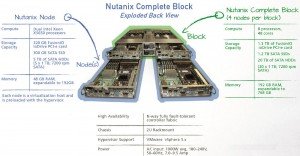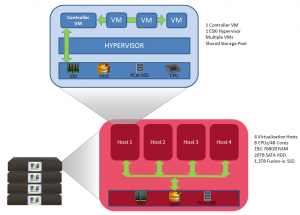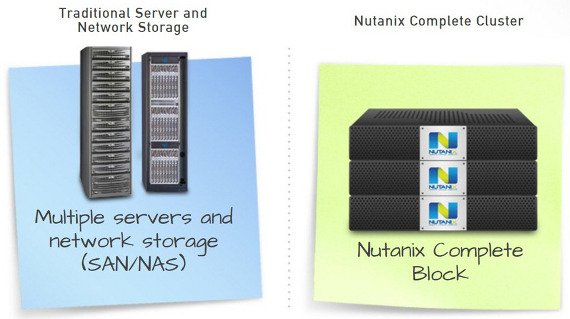This post is also available in: Italian
Reading Time: 4 minutes![]() Nutanix is a start-up company founded in in September 2009 with the scope to realize a new SAN-less virtualized datacenter platform, converging two tiers of infrastructure down to one. On May, 14th 2012, Nutanix has officially started its EMEA division.
Nutanix is a start-up company founded in in September 2009 with the scope to realize a new SAN-less virtualized datacenter platform, converging two tiers of infrastructure down to one. On May, 14th 2012, Nutanix has officially started its EMEA division.
The introduction video explains most the the basis concept of Nutanix storage approach. Also there are other blog that have a more exhaustive introduction (see in the final reference).
The storage solution is an innovative scale-out model, using local storage (for store the data), replication (to provide redundancy and better availability), a unified and distributed filesystem and that is able to run directly the VMs on the storage side (for more information of those concepts, see also the previous post).
 Each Nutanix node is a complete computing and storage (and networking) block that could really be a simple “plug-and-play” building block and also it could help in sizing and scaling. Each node is basically a server (with a standard Dual Intel Xeon X5650 processors 6 cores / 2.66GHz) with multi-tier local storage based on a Fusion IO card (320 GB), a SSD (300 GB) and some SATA disks (5 of 1 TB each). Of course it include RAM and networking cards (actually limited to 1x10GbE and 2x1GbE, but with more option in the future).
Each Nutanix node is a complete computing and storage (and networking) block that could really be a simple “plug-and-play” building block and also it could help in sizing and scaling. Each node is basically a server (with a standard Dual Intel Xeon X5650 processors 6 cores / 2.66GHz) with multi-tier local storage based on a Fusion IO card (320 GB), a SSD (300 GB) and some SATA disks (5 of 1 TB each). Of course it include RAM and networking cards (actually limited to 1x10GbE and 2x1GbE, but with more option in the future).
Nodes are on high density servers grouped in block (basically a block is just a mini-blade enclosure with 4 nodes).
 The storage part runs as a VSA on an bare metal hypervisor layer: actually is runs on ESXi 5.x, but the hypervisor layer is un-modified (so it can easy by managed as usual) and could become agnostic (although actually it used the VMDirectPath I/O pass-through feature of vSphere have a direct access at the physical components).
The storage part runs as a VSA on an bare metal hypervisor layer: actually is runs on ESXi 5.x, but the hypervisor layer is un-modified (so it can easy by managed as usual) and could become agnostic (although actually it used the VMDirectPath I/O pass-through feature of vSphere have a direct access at the physical components).
Scalability of computational resources is provided by the virtualization layer (for example using VMware Cluster, DRS, resource pools, ….). For the storage side is provided by a distributed and global file system: Nutanix Distributed File System (NDFS). Inspired by the Google File System, NDFS delivers a unified pool of storage from all nodes across the cluster, leveraging techniques including striping, replication, auto-tiering, error detection, fail-over and automatic recovery.
More interesting is how Nutanix provide a seamless support of features like vMotion,
HA and DRS: from the virtualization side the storage transparently view as a single and shared storage. But of course it works better only when data are locally to the VM. So what happen if a VM is moved between hosts? In a transparent way also its data block will be moved to the correct node to guarantee the better performance!
And what about HA in case of a node (or a block) failure? In this case each data has a replicated copy on another node, so the “copy” will replace the missing data (and of course replication is restored as soon is possible).
For more information see also:



